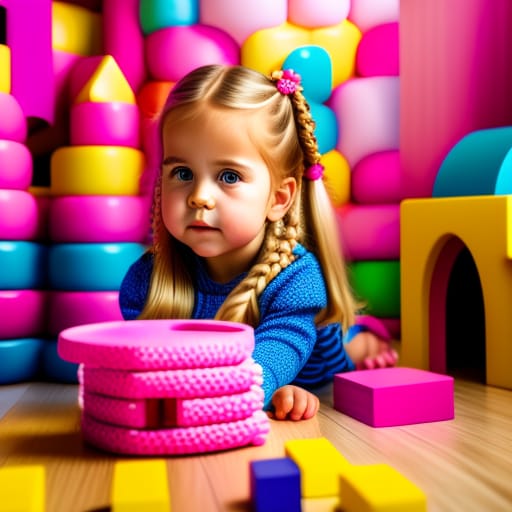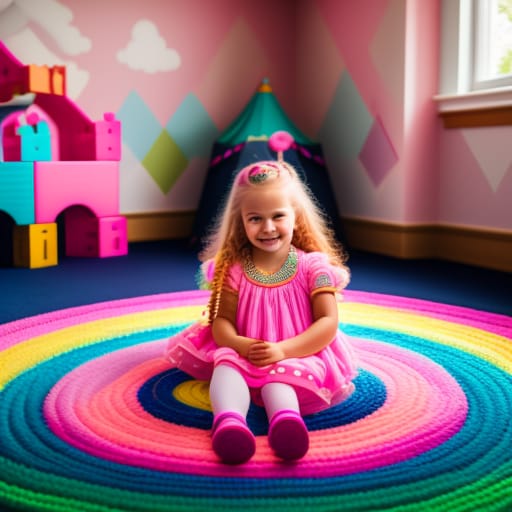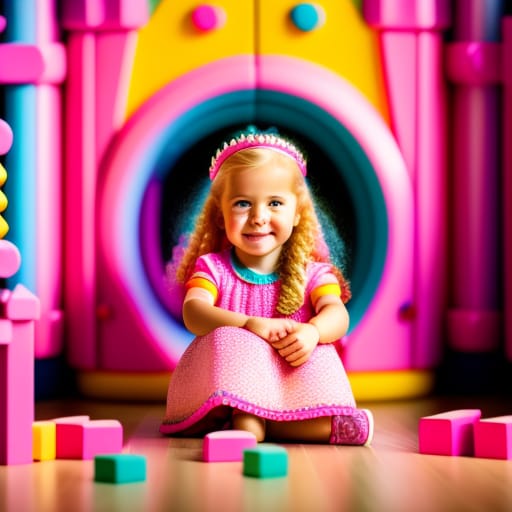Castles conjure up images of medieval knights, royal courts, and epic battles. As children, many of us dreamed of ruling our castle kingdom. With a set of castle building blocks, kids can design and build majestic castles right in their bedrooms!
Castle building blocks allow children to explore their creativity and imagination. Playing with castles also provides educational and developmental benefits. This beginner’s guide will explore the magical world of castle-building blocks.

What Are Castle Building Blocks?
Castle building blocks are construction toys designed to look like parts of medieval castles. They allow kids to build castles, forts, keeps, and other structures.
Building blocks come in many shapes and sizes. Common pieces include:
- Walls and towers – Straight and curved plastic or wooden blocks for building castle walls. Towers and turrets add height.
- Windows and doors – Openings to add realistic details.
- Battlements – Decorative cresting for castle walls.
- Roofs and arches – Peak-shaped roofs and curved brick arches.
- Minifigures – Small knight, princess, dragon, and castle-themed figures.
- Bridges and gates – Spanning structures to connect castle sections.
- Flags and banners – Decorative fabric elements.
The modular pieces allow endless design options. Kids use their creativity to build the castle of their dreams!
A Brief History of Castle Building Blocks
Building blocks have been popular children’s toys for centuries. Simple wooden blocks date back to the 1800s.
- 1900s – Cardboard building kits emerged, allowing kids to construct castles and other structures.
- 1950s – Plastic building bricks entered the market with the LEGO system.
- 1970s – More companies began making interlocking plastic castle sets.
- 2000s – Wooden castle blocks regained popularity for their eco-friendly nature.
Today, castle-building sets remain a beloved toy for inspiring the imagination in kids.
Types of Castle Building Blocks
There are two main types of castle building blocks: wooden and plastic. Each has unique advantages.
Wooden Castle Blocks
Wooden blocks are the classic option dating back over a century.
Features
- Made of natural wood like pine, maple, or beech.
- Painted with non-toxic colors and finishes.
- Some include magnets, allowing structures to stick together.
- Range of castle-themed shapes and accessories.
Advantages
- Eco-friendly and sustainable material.
- Warm, natural feel.
- Easier for small hands to grip and stack.
- Lightweight blocks are portable for on-the-go play.
Disadvantages
- More expensive than plastic blocks.
- Not as durable or impact-resistant as plastic.
- Wood can warp or crack over time.
Popular wooden block brands include Melissa & Doug, Hape, and Schylling.
Plastic Castle Blocks
Plastic blocks are inexpensive, durable, and easy to clean.
Features
- Molded from ABS plastic for strength and rigidity.
- Interlocking system for stable construction.
- Vibrant colors that appeal to kids.
- Large collections with 100+ pieces.
Advantages
- Budget-friendly price point.
- Extremely durable for extended use.
- Easy to clean with just soap and water.
- Larger sets provide more creative options.
Disadvantages
- Made of plastic which is not as eco-friendly.
- Can be noisy when stacking and arranging pieces.
- Sharp plastic edges may be uncomfortable for little hands.
Top plastic castle block brands include PicassoTiles, Playz, and SONGMICS.
Other Types of Castle Blocks
In addition to classic wood and plastic, some unique castle-building block options include:
- Cardboard – Sturdier than regular cardboard, laser-cut for precise shapes.
- Foam – Soft, lightweight foam pieces are easy to assemble.
- Magnetic – Magnetic bricks allow structures to stick together.
- Electronic – Light, sound, and movement activated by buttons.
- Inflatable – Blow up large vinyl castle structures.
Benefits of Castle Building Blocks
Playing with castle blocks offers numerous developmental and educational benefits for kids.
Educational Benefits
- Enhances creativity & imagination – Open-ended play inspires kids to dream up unique castle designs.
- Develops problem-solving skills – Children learn engineering concepts like stability and balance.
- Improves fine motor skills – Precision required to stack small blocks builds dexterity.
Social Benefits
- Encourages teamwork and cooperation – Collaborating on shared castles teaches compromise.
- Promotes communication and language – Describing and discussing castle plans builds vocabulary.
- Fosters sharing and turn-taking – Kids take turns adding pieces and using accessories.
Other Benefits
- Provides entertainment and fun – Interactive play engages kids in an imaginative world.
- Enhances cognitive development – Spatial reasoning skills are strengthened through block play.
- Promotes physical activity – Reaching, building, and manipulating pieces gets kids moving.
In short, castle-building sets offer a fun way for children to gain skills!
Factors to Consider When Choosing Blocks
If you’re looking to buy castle blocks, keep these key factors in mind:
- Age – Choose a size and complexity fitting for the child’s age and dexterity.
- Safety – Ensure blocks have smooth, non-toxic finishes. Avoid small pieces for toddlers.
- Material quality – Pick durable blocks that will last through rough play.
- Price – Building sets range from $20 for basic plastic to $100+ for expansive wooden castles.
- Brand reputation – Select a trusted brand known for high-quality children’s toys.
Also, consider your child’s interests. Does your son love knights and dragons? A medieval-themed castle is a perfect fit!
How to Use Castle Building Blocks
Once you’ve selected the ideal castle blocks, the real fun begins! Here are some tips for constructing castles:
Basic Building Techniques
- Start with a sturdy foundation using the largest, flattest blocks.
- Stack up wall sections, lining up the interlocking bricks.
- Place towers at the corners to establish the parameters.
- Use arches and roofs to bridge gaps between towers.
- Embellish with turrets, battlements, windows, and accessories.
Advanced Building Tips
- Incorporate ramps, lifts, and trap doors for multi-level designs.
- Build tunnels and secret passages to connect sections.
- Add a courtyard with towers all around the perimeter.
- Surround the castle with a moat and drawbridge entrance.
- Customize towers with different heights and roof styles.
Ideas for Different Castle Types
- Mountain Castle – Built into a rocky facade with cascading wall layers.
- Floating Island Castle – Create an isle castle on a wooden base “surrounded by water”.
- Gingerbread Castle – Decorate walls with candy-colored blocks and icing detail.
- Haunted Castle – Add creepy accents like bats, spiders, and skeletons.
Let kids’ imaginations run wild! Almost anything is possible with a box of castle building blocks.
Maintaining Castle Blocks
With lots of creative play, castle blocks will need some care. Here are handy upkeep tips:
Cleaning and Sanitizing
- Wipe wooden blocks with a damp cloth and mild detergent. Avoid soaking the wood.
- Clean plastic blocks in warm soapy water. Disinfect with diluted vinegar.
Storage and Organization
- Use labeled bins or cloth bags to sort pieces by type.
- Store out of direct sunlight to avoid fading colored blocks.
- Consider mounted wall racks for a neat display.
Repair and Replacement
- Superglue broken elements like turrets and minifigures.
- Replace damaged blocks to maintain the integrity of structures.
- Consider buying extra bricks for frequent replacements.
Proper care will keep castle blocks looking like new for years of creative play!

Child Development Benefits
In addition to sparking creativity and imagination, castle blocks support key areas of child development.
Cognitive Development
- Improves spatial intelligence, problem-solving, and planning skills.
- Handling small pieces develops fine motor control and coordination.
- Recognizing shapes boosts visual learning abilities.
Physical Development
- Stacking blocks strengthens muscles in the hands and arms.
- Eye-hand coordination is refined by the precision placement of pieces.
- Reaching and building improves balance and dexterity.
Social & Emotional Development
- Cooperative play teaches teamwork and sharing.
- Expressing ideas builds confidence and communication skills.
- Completing castles gives a great sense of pride and achievement.
Castle blocks offer well-rounded learning across developmental domains!
Using Castle Blocks in Education
Beyond home play, castle blocks have many applications in school classrooms.
Classroom Uses
- Storytelling – Have students build scenes as they read fairytales involving castles.
- History – Build medieval castles while learning about knights and chivalry.
- Math – Practice shapes, patterns, counting, addition, and fractions using blocks.
- Science – Conduct experiments on gravity, balance, and engineering.
- Art – Design castles inspired by famous paintings with Van Gogh’s “Starry Night”.
Benefits for Education
- Hands-on learning engages multiple senses.
- Aligns with STEM principles of science, math, and engineering.
- Allows creative freedom within the structure of an academic lesson.
- Develops problem-solving, critical thinking, and collaboration skills.
Castle blocks are a versatile manipulative across the curriculum!
Castle Block Lesson Ideas
- Language Arts – Write a story from the perspective of someone living in the castle.
- Geography – Build castles unique to countries and discuss architectural styles.
- Physics – Experiment with strength vs. height and demonstrate concepts like gravity.
- Geometry – Explore 2D and 3D shapes used in castle construction.
Castle blocks bring active learning to any subject.
Castle Blocks for Creativity
Free play with castle blocks fosters out-of-the-box thinking and creative expression in kids.
Enhancing Creativity
- Provide blocks without specific instructions to allow imaginations to wander.
- Combine castle blocks with other toys like action figures and animals for storytelling.
- Suggest new ideas like building an underwater castle or castle on Mars but let kids take the lead.
- Ask thought-provoking questions during play: What’s happening in your castle? Who lives there?
Creative Castle Projects
- Design your dream castle with your favorite foods, animals, and activities.
- Build a maze-like castle with booby traps and secret passages.
- Invent magical elements like potion rooms, dragon stables, and wizard towers.
- Craft a tiny castle landscape inside a shoebox.
Without pre-determined building outcomes, castle blocks become an art form for kids to color outside the lines!
Castle Building Blocks for STEM Learning
Castle sets are the perfect tool for engaging kids in hands-on STEM learning.
Use Castle Blocks to Teach STEM Concepts
- Science – Conduct experiments with physics concepts like balance and tensile strength.
- Technology – Incorporate coding robots to navigate through castle maze creations.
- Engineering – Apply principles of architecture and design for stable structures.
- Math – Explore geometry, patterns, counting, measurement, and fractions.
Benefits of STEM Education
- Problem-solving through design, testing, evaluating, and redesigning castles.
- Visual-spatial skills developed by assembling multi-dimensional creations.
- Understanding of STEM principles through active experimentation and building.
- Teamwork is required for large-scale castle construction.
Castle STEM Project Ideas
- Build a castle strong enough to withstand a mock trebuchet marshmallow attack.
- Create castle wall shapes with certain fraction sizes (ex. 1⁄4 square blocks).
- Use blocks to model perimeter and area concepts.
- Program a robotic dragon to fly around the castle perimeter.
Castle blocks provide a fun gateway to get kids engaged in core STEM learning!
Castle Blocks for Play Therapy
For children with special needs, castle blocks can provide therapeutic benefits.
Benefits of Castle Block Play Therapy
- Improve social skills through interactive play.
- Boost communication as kids explain castle designs.
- Allow safe emotional expression through imaginative narratives.
- Increase focus, creativity, and problem-solving abilities.
- Help develop fine motor control and coordination.
Therapeutic Castle Block Activities
- Assign collaborative castle building to encourage teamwork.
- Act out emotional scenarios like a dragon attack to process feelings.
- Build calming sensory castles with soft blocks and lights.
- Practice sequences and patterns by stacking blocks in order.
Special Needs Applications
- Help autistic kids strengthen social and communication abilities.
- Assist children with anxiety in expressing emotions through play.
- Improve ADHD focus through lengthier castle projects.
- Develop coordination for kids with motor challenges.
Occupational therapists often utilize castle blocks in pediatric sessions to address sensory, motor, and cognitive issues in an engaging, hands-on way.
Castle Blocks for Family Play
Beyond just benefiting kids, castle blocks are a great interactive toy for family playtime.
Family Benefits
- Quality bonding time combining learning and fun.
- Strengthens family relationships through collaboration.
- Parents gain insight into their child’s developing skills and interests.
- Provides screen-free entertainment to exercise imagination.
Family Castle Activities
- Build dream castles imagined by each family member.
- Act out dramatic scenes with castle blocks and action figures.
- Create castles inspired by books and movies.
- Have parents build a starter castle and let kids decorate rooms.
- Hold a family competition for the most impressive castle design.
Dedicate a table just for castle building so kids can constantly add on to their kingdoms as creative inspiration strikes!
Best Castle Blocks as Gifts
Looking for a present for the little prince or princess in your life? Castle building blocks make magical gift ideas!
Castle Blocks for Different Ages
- 1-3 years – Large, chunky blocks with simple castle graphics
- 3-5 years – Basic interlocking brick sets, 50-100 pieces
- 5-7 years – More complex builds with 200+ pieces, themed characters
- 8+ years – Elaborate realistic castles, 500+ pieces, light and sound effects
Gift-Giving Occasions
- Birthdays
- Holidays like Christmas, Easter, Hanukkah
- Vacation souvenirs
- Back-to-school gift
- Creative play gift assortment with books, costumes, and art supplies
Benefits of Castle Block Gifts
- Promotes creativity, imagination, and active learning.
- Screen-free entertainment option.
- Fun toy for solo, friend, and family play.
- Castle themes appeal widely to both boys and girls.
- Grows with the child as skills advance.
Surprise a special kid in your life with the gift of endless castle play possibilities!

Reviews of Top Castle Building Block Brands
With so many castle block products on the market, it can be tricky to select the best set. Here are reviews of leading brands:
Melissa & Doug Castle Blocks
Melissa & Doug is known for high-quality wooden toys. Their wooden castles feature intricately carved details.
Pros
- Sturdy wood construction
- Intricate textures and graphics
- Compatible with other sets for expanded builds
Cons
- Small parts may be a choking hazard for those under 3
- Relatively expensive
Best For – Kids 3-7 who will appreciate fine details
Magna-Tiles Clear Colors
These transparent interlocking magnetic blocks inspire unique castle creations.
Pros
- Endless combinations of shape and color mixing
- Magnets provide instant connections
- Encourages creativity beyond typical brick castles
Cons
- Magnets can be a choking risk if detached
- Only provides building shapes, no themed pieces
Best For – Kids 5+ who will relish imaginative designs
Playmobil Large Knight’s Castle
This complete Playmobil medieval castle set brings role-play to life.
Pros
- Massive set creates
Frequently Asked Questions About Castle Building Blocks
Castle blocks inspire endless questions as kids explore buildings. Here are answers to some common FAQs.
Are castle-building blocks safe for toddlers?
For ages 1-3, choose large chunky wooden blocks with no small parts. Plastic blocks may contain choking hazards. Always supervise young children during block play.
How are castle blocks educational for children?
Building castles enhances creativity, problem-solving, motor skills, and shapes recognition. Collaborative play develops teamwork and language skills. Castle blocks provide cross-curricular learning.
What are the best castle-themed blocks?
Look for leading brands like Melissa & Doug wooden blocks or Playmobil plastic sets. Seek blocks styled as castle walls, towers, roofs, and themed characters. Pick age-appropriate sizes.
Can I make castle blocks more challenging as my child gets older?
Start with simple stackable blocks, then transition to interlocking bricks for more complex builds. Add elements like ramps, lifts, and hinges for multi-layer designs. Let older kids take the lead on castle themes and construction.
How can I use castle blocks to teach STEM concepts?
Incorporate lessons on gravity, tensile strength, geometry, and spatial reasoning. Build mazes and obstacles to teach programming concepts with codable robots. Use measurement in castle construction.
Are castle blocks okay for children with autism or ADHD?
Yes, supervised block play provides great benefits for neurodiverse kids. The hands-on building engages focus and develops social-emotional skills. Allow creative freedom to make activities therapeutic.
What are fun ways to use castle blocks as a family?
Hold contests for the most creative castle or fastest build time. Act out dramatic scenes and stories. Build themed castles based on books and movies. Display finished castles on a shelf like a medieval village. Let castle block play spark family adventures!